Table of Contents
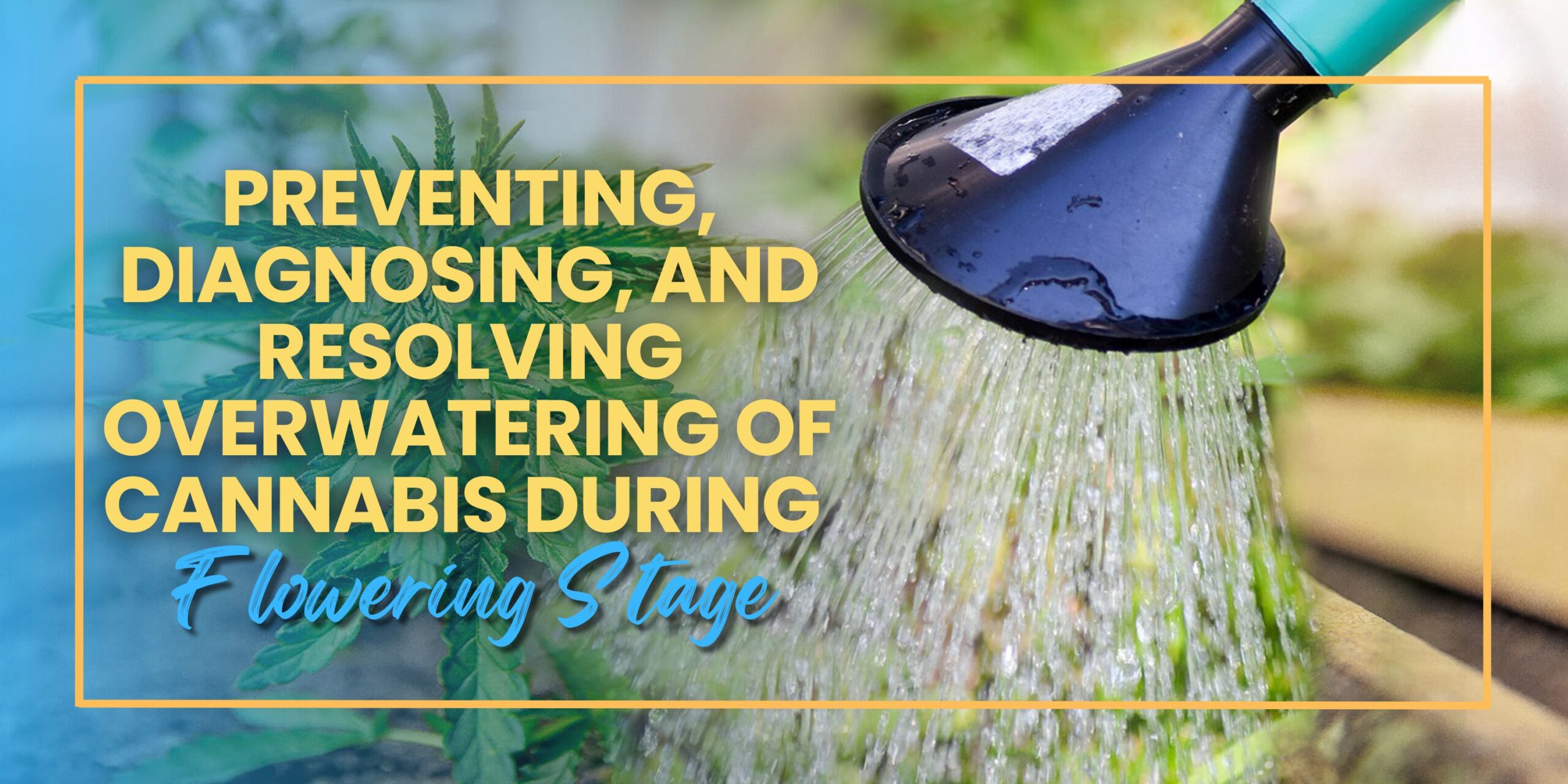
Water management is vital in plant health and overall yield. While most growers would focus on preventing dehydration, overwatering is an equally dangerous risk that can lead to stunted growth, root rot, and plant death. Overwatering occurs when plants receive more water than the roots can absorb, leading to a lack of oxygen at the root zone. In the absence of oxygen, roots suffocate and the plant weakens, becoming susceptible to fungal infections like root rot.
This tutorial will provide a thorough analysis of overwatering during the flowering stage, how to recognize it, why it occurs, methods for avoiding it, and how to correct it. Controlling these aspects will enable the growers to have healthy and robust plant development and yield potential. Indoor and outdoor cannabis cultivation, early detection of, and curing overwatering will significantly determine the success of your growth.
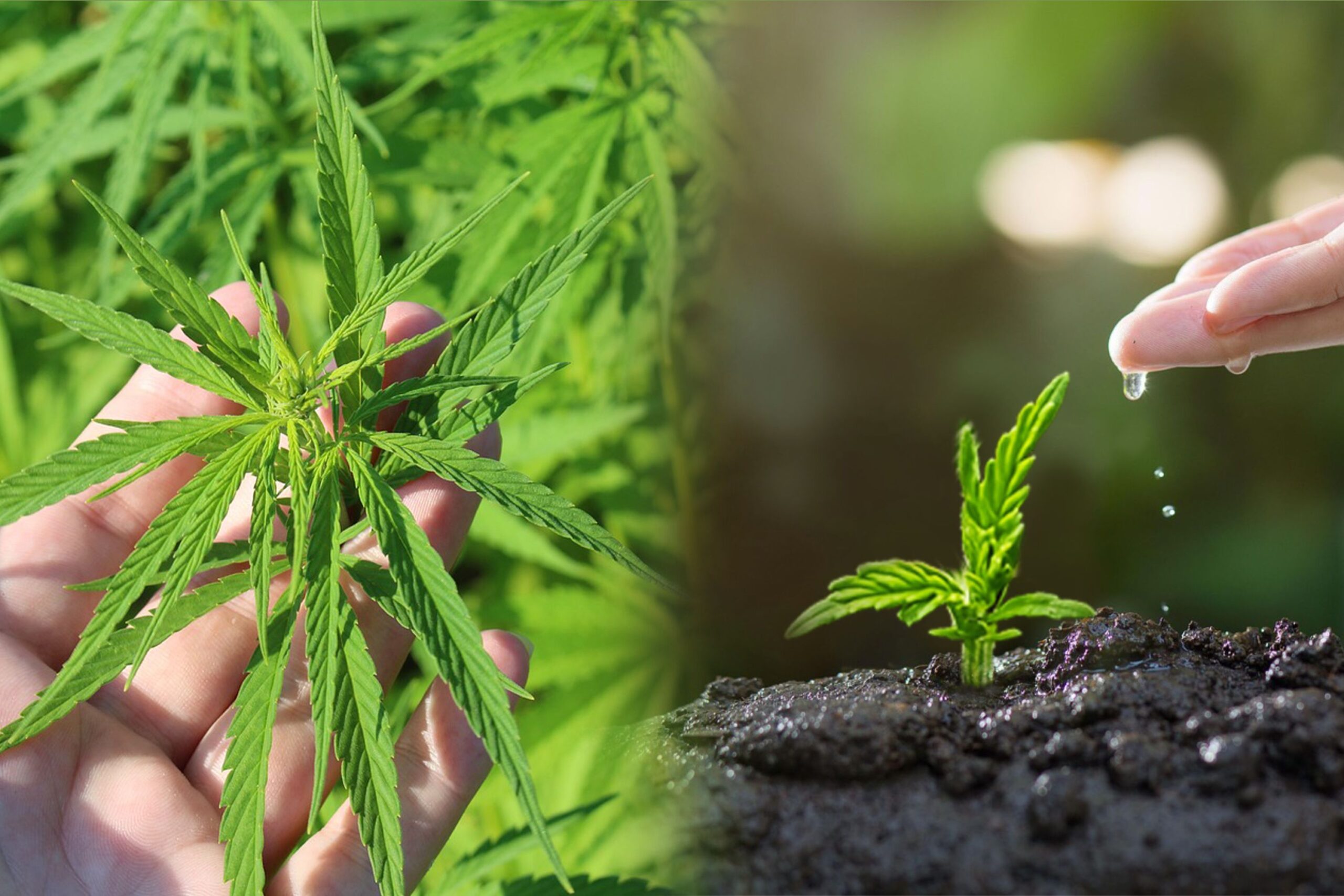
It’s likely the most common mistake gardeners make and one of the most avoidable. Overwatering happens when the soil contains too much water and remains there for too long, leaving roots basically without oxygen. Withholding sources of vital oxygen from roots makes the plant unable to absorb nutrients from the soil. It promotes paltry and frail growth and healthful development. But aside from not desiring the plant dead, this promotes unhealthy, problematic root pathogens such as Pythium, which lead to root rot.
Cannabis grows well in soil that has adequate aeration space to allow water drainage. Under continuous water cover of the root system, the plant’s metabolic activity is decreased, and biological functions such as nutrient uptake and breathing are hindered. Ultimately, overwatering weakens the plant so much that it cannot recover anymore, leading to permanent damage.
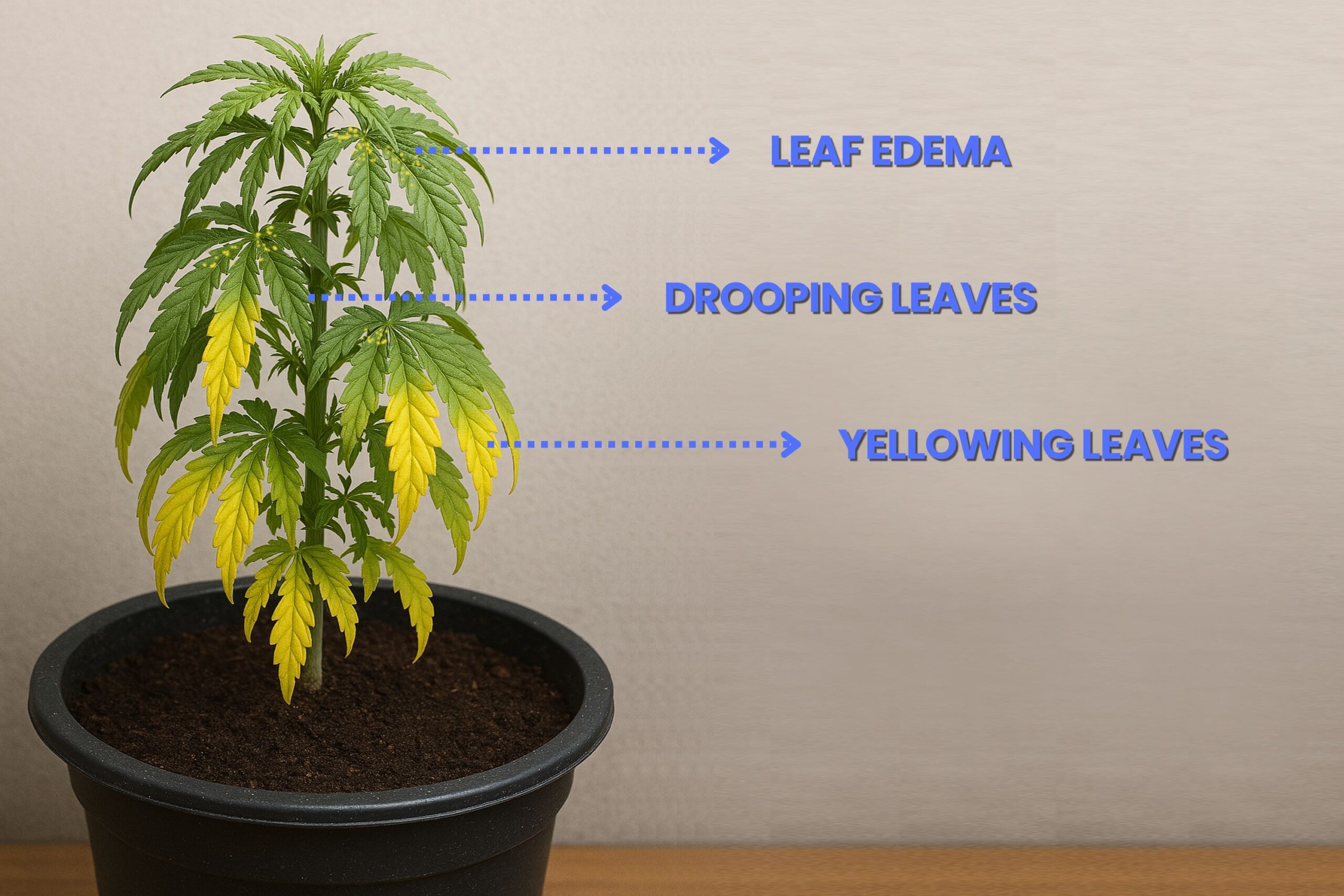
Identifying the initial signs of overwatering is important to correct the situation before permanent damage is done. The following are the most prevalent signs that suggest a cannabis plant has been overwatered.
1. Drooping Leaves
One of the first and most obvious symptoms of overwatering cannabis plants is wilting leaves. This sign might, at first sight, look like underwatering, leading numerous gardeners to misdiagnose the problem and provide further water, which in turn worsens the condition. Overwatered plants are different from under-watering weed plants, which get dry and brittle; they usually get puffy, swollen leaves that wilt even in excess water.
When a plant receives an excess of water, it becomes impossible for the roots to breathe, thus its process of nutrition and moisture distribution is impaired. This produces a slow and frail appearance, where leaves appear dead even when the soil is moist. The leaves may start curling underneath if not addressed, another indication of an excess of water in absorption.
2. Yellowing Leaves
Another significant indicator of overwatered weed plants is yellow leaves, which are a result of the inability of the plant to uptake basic nutrients. Without sufficient oxygen supply in the root system because of excess water, it is not able to uptake nitrogen and other important elements, thus causing nutrient deficiency in the form of yellow leaves.
Yellow leaves will typically start at the base of the plant and work their way up. A bit of yellowing during late flowering is to be expected, but yellowing during vegetative or early flowering growth is cause for concern. If it’s caused by overwatering, the yellowed leaves will also be puffy or very soft.
In cases of prolonged overwatering, leaves begin to exhibit brown edges or areas of necrotic spots due to root injury. In case of root rot, the entire plant can undergo systemic collapse leading to death of the plant.
3. Leaf Edema and Mold Development
Leaf edema is another sign of overwatering, as the plant cells absorb more water than they can transpire. This forms small, blister-like formations on the underside of leaves. These blisters may later rupture and leave brown scars or deformed leaves.
Excess moisture also offers a breeding ground for fungal pathogens and mold. A musty, moldy odor from the soil is a clear indication that the plant is experiencing excessive moisture retention. White fuzzy mold on the soil surface or at the stem base is an indication that requires immediate action to dry out the medium and provide more air circulation.
Knowledge of the main causes of overwatering aids in preventing its occurrence. There are numerous reasons behind excessive moisture retention during cannabis growing:
1. Heightened watering frequency
The majority of growers, especially beginners, irrigate their crops on a predetermined schedule rather than monitoring the plant’s actual requirements. Cannabis plants require different amounts of water depending on their developmental stage, growth conditions, and soil type. Too frequent overwatering in small amounts will progressively render the soil waterlogged.
2. Inadequate Soil Composition and Drainage
Planting in a dense or compacted soil mix will retain water around the roots, slowing down drainage. Heavy clay soil or unamended potting soil can hold water for weeks, thus heightening the chances of overwatering. To enhance aeration and drainage, incorporating perlite, coco coir, or sand into the soil mix will greatly enhance the structure.
Pots without sufficient drainage holes also tend to hold water at the bottom and produce root smothering. The growers must ensure pots have drainage and should never utilize trays with leftover water which is not allowed to evaporate.
3. Environmental Conditions
Temperature and humidity conditions have a direct impact on the transpiration rate and water needs of a plant. Plants need less water under cold, humid conditions, so farmers need to adjust their watering schedule accordingly. Failure to do so can cause water buildup in the soil and lead to overwatering issues.
Preventing overwatering is easier than reversing its impact. The following are the best practices to guarantee that cannabis plants get an even watering schedule:
1. Use the Right Watering Method
Rather than watering by schedule, planters should feel the soil to see if it needs water before adding it. The general principle is to water when the upper 1-2 inches of soil is dry—it’s wet, wait till tomorrow before repeating the test.
2. Maximize Drainage and Aeration of Soil
Selecting the right soil blend is critical to prevent overwatering. A well-draining potting mix that is loose and aerated and has added perlite, coco coir, or vermiculite will ensure that waterlogging does not occur. In addition, using fabric pots or multi-draining pot containers can offer a drainage route for excess water to escape, preventing waterlogging.
3. Adjust Watering Based on Plant Growth Stage
Seedlings require minimal water, as their root systems are still developing. Overwatering at this stage can easily drown young plants. As cannabis matures, its water requirements increase, but growers must still avoid excessive saturation. Monitoring leaf structure, soil conditions, and environmental factors will help determine the right watering schedule.
Watering in excess can be avoided by observation, soil choice, and scheduled watering. Farmers can help ensure that the detrimental effects of water surplus are not brought about by monitoring the way the cannabis plant responds to water and adjusting cultivation practices accordingly. The capacity to observe initial warning signs, such as yellow or wilted leaves, will allow intervention in time, preserving a healthy and fruitful cannabis garden.
1. Do overwatered cannabis plants recover?
Yes, cannabis plants do recover from overwatering when done early. Allow the soil to dry completely before watering again, enhance drainage, and provide good airflow around the roots to avert additional damage.
2. How long will it take for an overwatered plant to recover?
Recovery time depends on the degree of overwatering. Mild cases will recover in a few days, but those that have root rot can take two weeks to a week with proper care and soil correction.
3. Is underwatering or overwatering cannabis plants better?
It is preferable to underwatered weed plants than overwater since cannabis plants bounce back faster from a little dehydration than from suffocating water in the roots for a long time. Water after checking the moisture of the soil.
4. Can hydrogen peroxide be used to treat overwatered cannabis plants?
Yes, a diluted hydrogen peroxide solution (3% in water) will oxygenate the roots and destroy detrimental bacteria due to overwatering. It must, however, be used sparingly to avoid harming beneficial microbes.
5. Do cannabis plants in hydroponics suffer from overwatering?
No, hydroponic setups provide oxygen directly to the roots through aeration, so overwatering cannot take place. However, improper oxygenation or stagnant water will still cause root rot and other issues.
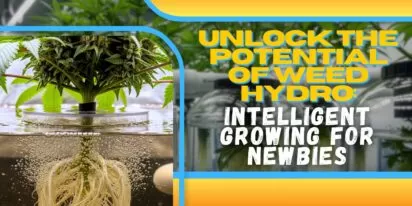
Curious about growing weed in a healthy, effective way? Welcome to the realm of weed hydro! This method uses water instead of soil, delivering n

Peyote Zkittlez is a unique cannabis strain that has quickly gained dedicated followers among enthusiasts and patients alike. Its parentage—Zk
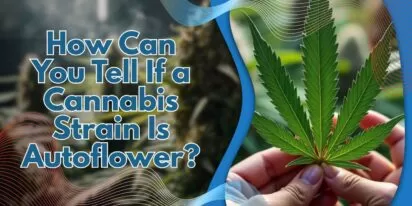
As growers, we want strains that work well, are strong, and are of good quality. Autoflowering cannabis strains are a big step forward for both

Pot growers always ask the same basic question: How much weed does a weed plant produce? The answer is complex and depends on a multitude of var

Ever had the room spin after a few hits? You're not alone. Figuring out how to prevent getting dizzy high can make your cannabis experience a wh
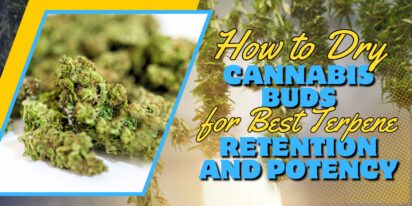
Drying cannabis properly is a critical process in preserving the plant's full aroma and flavor and its psychoactive abilities. Tampering with th

Ever caught yourself a bit too high and all of a sudden in need of being normal? Whether you're heading out for munchies or bumping into someone

Looking for sage advice on how not to get pinched with weed without batting an eye? Attempting to protect your stash from gossipy roommates, sno

Nutrient lockout, also known as nutrient binding or chemical antagonism, is a significant issue in cannabis cultivation that negatively impacts

Germination is the most critical initial stage in growing healthy, high-quality cannabis plants. During germination, the dormant seed becomes a
Are You 18 Or Over?
By selecting “Continue”, you confirm that you are at least 18 years of age and legally permitted to access cannabis related content in your region.
By using Rocketseeds.com, you agree to our legal disclaimer.
Excellent blog here Also your website loads up very fast What web host are you using Can I get your affiliate link to your host I wish my web site loaded up as quickly as yours lol
Your writing is not only informative but also incredibly inspiring. You have a knack for sparking curiosity and encouraging critical thinking. Thank you for being such a positive influence!
Simply wish to say your article is as amazing The clearness in your post is just nice and i could assume youre an expert on this subject Well with your permission let me to grab your feed to keep updated with forthcoming post Thanks a million and please carry on the gratifying work
Somebody essentially lend a hand to make significantly articles Id state That is the very first time I frequented your website page and up to now I surprised with the research you made to make this actual submit amazing Wonderful task
Your blog is a beacon of light in the often murky waters of online content. Your thoughtful analysis and insightful commentary never fail to leave a lasting impression. Keep up the amazing work!
Thank you for the auspicious writeup It in fact was a amusement account it Look advanced to more added agreeable from you By the way how could we communicate
Your blog is a constant source of inspiration for me. Your passion for your subject matter shines through in every post, and it’s clear that you genuinely care about making a positive impact on your readers.
Your blog is a constant source of inspiration for me. Your passion for your subject matter is palpable, and it’s clear that you pour your heart and soul into every post. Keep up the incredible work!
Your articles never fail to captivate me. Each one is a testament to your expertise and dedication to your craft. Thank you for sharing your wisdom with the world.
Your blog is a testament to your dedication to your craft. Your commitment to excellence is evident in every aspect of your writing. Thank you for being such a positive influence in the online community.
Your writing has a way of resonating with me on a deep level. I appreciate the honesty and authenticity you bring to every post. Thank you for sharing your journey with us.
Your blog is a true gem in the world of online content. I’m continually impressed by the depth of your research and the clarity of your writing. Thank you for sharing your wisdom with us.
Hi i think that i saw you visited my web site thus i came to Return the favore Im attempting to find things to enhance my siteI suppose its ok to use a few of your ideas
Somebody essentially help to make significantly articles Id state This is the first time I frequented your web page and up to now I surprised with the research you made to make this actual post incredible Fantastic job
Usually I do not read article on blogs however I would like to say that this writeup very compelled me to take a look at and do so Your writing taste has been amazed me Thanks quite nice post
Your blog has quickly become one of my favorites. Your writing is both insightful and thought-provoking, and I always come away from your posts feeling inspired. Keep up the phenomenal work!
Every time I visit your website, I’m greeted with thought-provoking content and impeccable writing. You truly have a gift for articulating complex ideas in a clear and engaging manner.
Hey there You have done a fantastic job I will certainly digg it and personally recommend to my friends Im confident theyll be benefited from this site
I have read some excellent stuff here Definitely value bookmarking for revisiting I wonder how much effort you put to make the sort of excellent informative website
Nice blog here Also your site loads up very fast What host are you using Can I get your affiliate link to your host I wish my site loaded up as quickly as yours lol
What i do not understood is in truth how you are not actually a lot more smartlyliked than you may be now You are very intelligent You realize therefore significantly in the case of this topic produced me individually imagine it from numerous numerous angles Its like men and women dont seem to be fascinated until it is one thing to do with Woman gaga Your own stuffs nice All the time care for it up
Your blog is a beacon of light in the often murky waters of online content. Your thoughtful analysis and insightful commentary never fail to leave a lasting impression. Keep up the amazing work!
Your blog is a breath of fresh air in the often stagnant world of online content. Your thoughtful analysis and insightful commentary never fail to leave a lasting impression. Thank you for sharing your wisdom with us.
Your blog is a beacon of light in the often murky waters of online content. Your thoughtful analysis and insightful commentary never fail to leave a lasting impression. Keep up the amazing work!
Usually I do not read article on blogs however I would like to say that this writeup very compelled me to take a look at and do it Your writing style has been amazed me Thank you very nice article
Your writing has a way of resonating with me on a deep level. I appreciate the honesty and authenticity you bring to every post. Thank you for sharing your journey with us.
This hydroponics guide is quite the buzz, seriously! Who knew growing weed without dirt could be so complicated yet potentially rewarding? The breakdown of systems like DWC and NFT is helpful, though I suspect my cat might confuse the air pump for a toy. The idea of cleaner buds is tempting, especially since explaining hydro weed to my non-growing friends might get messy. And the bit about potential dizziness from hydro weed? Perfect, now I have an excuse for why I always stumble a bit after a grow session. Still, the promise of faster grows and higher yields is hard to ignore, even if it means more trips to the pH meter than to the coffee shop. Overall, a cultivating read for the curious grower!